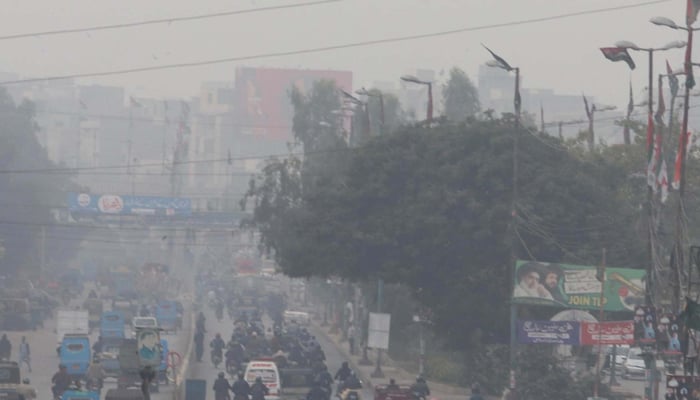There’s something in the air
Karachi, like other cities in Pakistan, is facing a huge problem of poor solid waste management and air pollution
When one returns from a foreign country to Karachi, s/he is met with garbage issues and an assault on one’s olfactory senses. The city of Karachi today is not only full of crime but also faces the problem of heaps of trash and a revolting stench.
Karachi, like other cities in Pakistan, is facing a huge problem of poor solid waste management and air pollution. On average, waste collection rates in Karachi are 60 per cent, when it generates more than 16,500 tons of municipal waste daily.
This is a multifaceted problem that connects waste with air pollution. It not only requires green interventions from the government, but also behavioural changes by a majority of the population.
Karachi was once known as the city of lights. Unfortunately, Karachi now has one of the highest levels of pollution, followed by New Delhi in India and Lahore in Pakistan.
Particularly, Karachi has lower air quality with 260 particulate matters in the air. The Global Liveability Index of 2023, published by the Economist Intelligence Unit (EIU), ranks Karachi city as the fifth worst city to live in. This ranking is mainly due to a high crime rate, low air quality, and lack of infrastructure. Every day people are dealing with lower air quality and poor waste management even if they are not mugged.
The question that comes to one’s mind is what happened to this city. What turned it into a city full of plastic trash, unclean streets, open sewers, and days of indescribable stench?
People’s behaviour is partly contributing to the problem. But other reasons are the lack of an efficient municipal solid waste system provided by the government and the downstream flow of municipal waste from other districts in Sindh and from other provinces of Pakistan.
Every individual living in Karachi can recognize poor solid waste management problems in their daily life. People from less-developed areas, for instance Sohrab Goth, Sachal Goth, Safoora, etc, are dealing with this problem more than those living in posher areas. For instance, one can find trash in front of commercial shops, unclean streets in residential areas, piles of municipal waste including plastic disposable items beside the Lyari Expressway, and open sewers in posh housing societies.
Similarly, people visiting the Karachi Beach can easily see how polluted the sea is. For example, wastewater flowing directly into the coastal water; second, garbage patches can also be found right before the beach.
Third, if you wish to enjoy the seawater, you will find deflated balloons, plastic wrappers of bubble gum and ‘supari’ (mouth freshener), and other waste material flowing in the water. Globally, beaches are recreational sites which provide aesthetic pleasure to visitors and mental peace; they are also treated as a source of revenue and employment for the economy. However, the Karachi Beach has problems of pollution and an ever-lasting stench.
It is interesting to know how people treat waste, including plastic items. Littering on roads is quite common in Karachi. People casually throw trash while driving on roads, which risks others’ lives, or walking down on streets after consuming products.
Second, they pay garbage collectors to take trash from their homes. If we ask where that trash goes, most people may even do not know about it. Most of it goes to a kachra kundi where it gets burnt. Hence, people are taking out trash from their homes to burn it somewhere else.
The problem of bad odour stems mainly from the practice of open-air burning of trash and open sewers. Particularly, open-air burning can be found both at a small scale on the side of roads or at a large scale on an empty plot. Smoke from this burning leads to a nasty smell for hours. Studies also provide evidence of air pollution leading to health problems in Karachi. This is because most of the solid waste generated every day lies on low-lying land or gets burned in open air.
Regionally, it is possible that kachra kundis move out of developed to underdeveloped suburban regions over time. With the given capacity of dealing with solid waste, rapid urbanization, and population growth, it means more open-air burning of trash activity is likely to occur. This can lead to an increase in the number of smelly days in Karachi.
It is really important to highlight that smell can travel with air from one to another area. It means that inefficient solid waste management has a trade-off with smelly days. Even people who regularly take out trash from their homes will have to bear the consequences of this smell and expected health issues throughout Karachi.
After addressing the causes of the problem and future expectations, it is crucial to discuss solutions and policies. In 2019, the Sindh government started a cleanliness drive and gave orders of arresting people guilty of littering under Section 144 for 90 days. However, the act of spitting and littering in public is still quite common which raises concerns of effectiveness. Therefore, there is a need for raising awareness of the problem among all stakeholders of Karachi.
The main source of leftover on roads and streets can be addressed by creating amending people’s behaviour in education, government and private organizations. Along with that, the government can play its role in providing better solid waste management services by regularly cleaning streets and roads. However, it is also important to understand why people prefer paying a monthly fee to the garbage collector, but not the government’s municipal service.
For future urban planning, the government should regularize ‘kachra kundis’ in urban and sub-urban areas. The collected waste can be used for recycling, generating energy, and making fertilizers. If we treat this huge waste correctly, it can be a blessing in disguise. Waste leftovers can be treated with controlled incineration. It has quite popular benefits of reduced quantity of waste, efficient waste management, production of heat and power, less odour, etc.
Better air quality is the right of people living in Karachi. To reduce the current levels of air pollution, the government and people should collectively start a tree plantation drive which can partly contribute to the carbon sequestration process.
The government also needs to support this by investing in greener interventions and efficient waste management systems.
Dr Ghamz E Ali is a research fellow, and assistant professor at the Centre for Business and Economic Research, and School of Economics and Social Sciences (SESS), IBA, Karachi.
Dr Heman Das Lohano is a professor at the SESS, IBA, Karachi.
-
 Newborns At Risk: Health Experts Warn Your Baby Could Already Have Diabetes
Newborns At Risk: Health Experts Warn Your Baby Could Already Have Diabetes -
 Sarah Ferguson Updates Her Plans Now That Andrew’s Eviction Is Nine Days Away
Sarah Ferguson Updates Her Plans Now That Andrew’s Eviction Is Nine Days Away -
 Hailey Bieber Sends Cease And Desist To TikToker
Hailey Bieber Sends Cease And Desist To TikToker -
 Kate Middleton Celebrates England Women's Rugby Stars After World Cup Win
Kate Middleton Celebrates England Women's Rugby Stars After World Cup Win -
 Kris Jenner Dubs Chicago West Her 'sweet Angel' As She Turns Eight
Kris Jenner Dubs Chicago West Her 'sweet Angel' As She Turns Eight -
 Josh Charles Credits Taylor Swift For His, Ethan Hawke’s Moon Person Trophies
Josh Charles Credits Taylor Swift For His, Ethan Hawke’s Moon Person Trophies -
 Jodie Foster Voices Opinion About 'misogyny'
Jodie Foster Voices Opinion About 'misogyny' -
 Virginia Madsen Remembers Late Brother Michael Madsen Six Months After His Death
Virginia Madsen Remembers Late Brother Michael Madsen Six Months After His Death -
 Emilia Clarke Reveals Real Price Of Playing Daenerys In 'Game Of Thrones'
Emilia Clarke Reveals Real Price Of Playing Daenerys In 'Game Of Thrones' -
 Ex-Chicago Mayor Hit With Lawsuit Over Unpaid Credit Card Bills
Ex-Chicago Mayor Hit With Lawsuit Over Unpaid Credit Card Bills -
 Andrew Risks His Relationships With Princess: ‘She’s Supporting The Abused And It’s Festering’
Andrew Risks His Relationships With Princess: ‘She’s Supporting The Abused And It’s Festering’ -
 Harry Styles Unveils New Album After Cryptic Posters Spark Fan Frenzy
Harry Styles Unveils New Album After Cryptic Posters Spark Fan Frenzy -
 Prince Harry Ready To Return To The UK To King Charles But It’ll Depend On How THIS Goes
Prince Harry Ready To Return To The UK To King Charles But It’ll Depend On How THIS Goes -
 Why Isn't King Charles Mourning Death Of His Father's First Cousin?
Why Isn't King Charles Mourning Death Of His Father's First Cousin? -
 Nicole Richie Breaks Silence On Her Daughter's Name Change
Nicole Richie Breaks Silence On Her Daughter's Name Change -
 Truth Behind Chris Noth, Sarah Jessica Parker's Ongoing Feud Revealed
Truth Behind Chris Noth, Sarah Jessica Parker's Ongoing Feud Revealed




